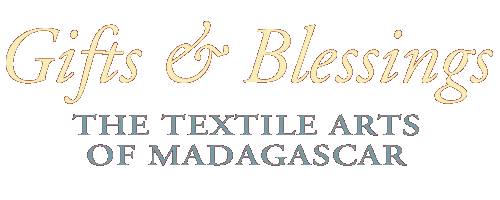|

 Beyond
its role as elegant and expressive clothing, Madagascar's handwoven cloth,
or lamba, serves as a ceremonial gift and a valued symbol of the
island's cultural and artistic heritage. The Malagasy -- the peoples of
Madagascar -- offer cloth to rulers, ancestors and spirits in return for
blessings. In these instances, cloth becomes a material manifestation
of hasina, a mystical, sacred force that strengthens human relationships. Beyond
its role as elegant and expressive clothing, Madagascar's handwoven cloth,
or lamba, serves as a ceremonial gift and a valued symbol of the
island's cultural and artistic heritage. The Malagasy -- the peoples of
Madagascar -- offer cloth to rulers, ancestors and spirits in return for
blessings. In these instances, cloth becomes a material manifestation
of hasina, a mystical, sacred force that strengthens human relationships.
The Malagasy exchange cloth to demonstrate ethnic identity, status and ties of mutual respect and loyalty. Continuing time-honored traditions, men offer cloth to their brides at marriage; bride and groom are encircled in a single cloth to symbolize their union; and descendants honor their ancestors through the wearing and offering of cloth in burial rites and other ceremonies.
In the past, rulers and subjects exchanged cloth to create and renew alliances. This exchange extended to the sphere of international diplomacy. In this exhibition there are two silk lamba presented in 1886 by Madagascar's Queen Ranavalona III to Grover Cleveland, the 22nd president of the United States.
 The
central role of cloth in funeral rites throughout Madagascar--as gifts
from the living to their ancestors--may well account for the enduring
prominence of handwoven textiles. The
central role of cloth in funeral rites throughout Madagascar--as gifts
from the living to their ancestors--may well account for the enduring
prominence of handwoven textiles.
Pictured above (from top to bottom)
A Malagasy mother and her baby
Photographer unknown, c.1900
Collotype
Postcard Collection, MG-20-3
Eliot Elisofon Photographic Archives
National Museum of African Art, Smithsonian Institution
Throughout Madagascar, cloth is used to honor the dead and to show respect to revered ancestors. In this photograph, the coffin of a deceased Tanala elder is covered with a striped handwoven cloth during a mourning ceremony
Photograph by Philippe Beaujard 1976
Web site credits
Read the Press Release (English)
French version
|

 Back to: NMAfA past exhibits
Back to: NMAfA past exhibits